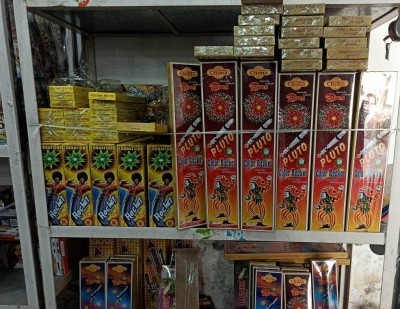
Chennai, Is it going to be a sparkling bright or dark Diwali is the question that is being asked by the fireworks industry for the past couple of years.
With Diwali this year to be celebrated next month - and virtually without any curbs and the Covid pandemic wanes, the question gains more importance.
Production of fireworks in Sivakasi in Tamil Nadu's Virudhunagar district, is yet to pick up even as there is just a month to go for the festival of lights, industry officials said.
The Supreme Court had banned the use of barium in 2018 in making firecrackers and it was reconfirmed in 2021, putting the fireworks industry in Sivakasi - the firecrackers hub of the country with around three lakh workers directly employed in around 1,000 organised units there - in a tight spot, they said.
"The case is still pending in the Supreme Court. The court had earlier said the final hearing will be in June 2022. But that has not happened," Sivakasi Fireworks Manufacturers Association (SFMA) Vice President A. Murali told IANS.
"The ban of barium is baseless, imposed without any scientific study being conducted on the possible hazardous impact with regards to the pollution."
"We are being targeted because of the hue and cry of the environmentalists in the name of pollution, although other sectors as well are using barium in various production operations. I should say that we are the weaker opponent and are being made scapegoats," Murali contended.
After the SC had reconfirmed the ban in 2021, many of the stakeholders have impleaded in the case seeking lifting of the ban.
Murali said, barium is one the main oxidisers for most of the fireworks and without it, the simple sparklers cannot be made.
"After the ban, my factories are running at 50 per cent capacity and reduced production by 50 to 60 per cent which obviously impacted the business. For instance, I have a group of companies which employs 450 to 500 workers and after the ban I could employ 200 people only," he said.
The production value of firecracker factories in Sivakasi is about Rs 2,500 crore and the retail sales value may be about Rs 6,000 crore.
For a long time, the fireworks industry has been a target in different forms.
First, the manufacturers were targeted for child labour and it was followed up with the noise pollution charge. With the noise pollution issue getting resolved with the laying down of the norms, the industry is being charged with polluting the air.
"The next charge may be that the brightness emitted by the firecrackers are injurious to the human eyes," claimed an industry player.
The industry players and common people are of the view that Diwali is being targeted by vested interests.
Manufacturers say that Sivakasi would have turned into a ghost city long back if firecrackers were the reason for air pollution in Delhi.
On an average, the industry players daily burst around Rs 1,00,000 worth of crackers for testing purposes, but people breathe good air and there are different kinds of birds in Sivakasi, industry officials had told IANS.
Sivakasi accounts for nearly 90 per cent of the country's firecracker production, and has 1,070 firecracker units located in and around the city.
About 300,000 workers are directly employed whereas another 500,000 workers are in the allied sectors.
"The automobile industry was given a long buffer time to shift over to the BS VI emission norms. But the fireworks industry was not given any norms or time to change over," a manufacturer had told IANS.
Industry officials have been questioning the efficacy of the formulation provided by the Council of Scientific and Industrial Research (CSIR) and the National Environmental Engineering Research Institute (NEERI) to make green crackers.
As per Murali and other industry officials, the NEERI claims that using its formulation in firecracker manufacturing, the emission levels will go down by 30 per cent but this "is not scientific".


.jpeg)

